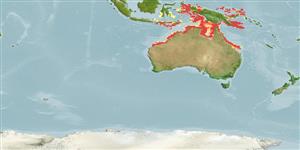Common names from other countries
(كوسه ها و سپرماهيان) (sharks and rays) >
Orectolobiformes (Carpet sharks) >
Orectolobidae (Carpet or nurse sharks)
Etymology: Eucrossorhinus: eu (Gr.), very; Crossorhinus (=Orectolobus), previous genus, from krossos (Gr.), fringe or tassel, referring to tassel of dermal lobes fringing the head, and rhinus, an ancient name for sharks, from rhine (Gr.), rasp, alluding to their rasp-like skin, or rhinos, snout, referring to “lobe-like attachments from the nose” (translation, from Müller & Henle’s 1837 description of Crossorhinus). (See ETYFish); dasypogon: dasys (Gr.), hairy; pogon (Gr.), beard, referring to dense beard-like tassel of dermal lobes fringing the head. (See ETYFish).
More on author: Bleeker.
Environment: milieu / climate zone / depth range / distribution range
بوم شناسي
دريايي وابسته به آب سنگ; تغييرات عمق 2 - 50 m (Ref. 106604). Deep-water; 1°N - 23°S, 115°E - 155°E
Indo-West Pacific: eastern Indonesia, Papua New Guinea, and northern Australia (including Barrow Island, Western Australia). Questionable occurrence in Malaysia.
Size / Weight / سن
Maturity: Lm ? range ? - ? cm
Max length : 366 cm TL جنس نر / بدون خواص جنسي; (Ref. 90102); common length : 180 cm TL جنس نر / بدون خواص جنسي; (Ref. 90102)
خارهاي باله پشتي (کل) : 0; خارهاي باله مخرجي: 0. Body with a reticular pattern of narrow dark lines (Ref. 13577). Caudal fin with its upper lobe hardly elevated above the body axis, with a strong terminal lobe and subterminal notch but no ventral lobe (Ref. 13577).
A little-known shark (Ref. 247) found on the continental shelf and offshore reefs (Ref. 6871). Probably feeds on bottom fishes and invertebrates (Ref. 13577, 43278); also known to eat nocturnal teleost fishes such as squirrelfish and soldierfish (Holocentridae) and sweepers (Pempheridae) (Ref. 43278). Ovoviviparous (Ref. 50449). Might bite in self-defense or when mistaking a human foot for its usual prey (Ref. 247). Its tough skin sometimes used for leather (Ref. 13577). The maximum length of 366 cm TL reported for this species is uncertain (Ref. 247, 90102).
Life cycle and mating behavior
Maturities | تولید مثل | Spawnings | Egg(s) | Fecundities | توزاد ( لارو)
Ovoviviparous, embryos feed solely on yolk (Ref. 50449).
Compagno, L.J.V., 1984. FAO Species Catalogue. Vol. 4. Sharks of the world. An annotated and illustrated catalogue of shark species known to date. Part 1 - Hexanchiformes to Lamniformes. FAO Fish. Synop. 125(4/1):1-249. Rome, FAO. (Ref. 247)
وضعيت در فهرست قرمز IUCN (Ref. 130435)
CITES (Ref. 128078)
Not Evaluated
استفاده انسانی
ابزارها
گزارش های ويژه
بارگيری XML
منابع اينترنتي
Estimates based on models
Preferred temperature (Ref.
115969): 26.2 - 28.8, mean 27.8 (based on 294 cells).
Phylogenetic diversity index (Ref.
82804): PD
50 = 1.0002 [Uniqueness, from 0.5 = low to 2.0 = high].
Bayesian length-weight: a=0.00389 (0.00180 - 0.00842), b=3.12 (2.94 - 3.30), in cm Total Length, based on all LWR estimates for this body shape (Ref.
93245).
Trophic level (Ref.
69278): 4.0 ±0.60 se; based on food items.
جهندگی (Ref.
120179): پايين ، كم, كمينه زمان لازم براي دو برابر شدن جمعيت 5/4 – 14 سال (Fec assumed to be <100).
Fishing Vulnerability (Ref.
59153): Very high vulnerability (90 of 100).
